Any meeting worth having is worth planning- except the ad hoc meeting. These impromptu get-togethers, often called with little to no warning, can be necessary. They can help resolve urgent issues, respond to shifting priorities or clear up a blocker that just can’t wait. However, without structure, they can quickly derail focused work, leave teams scrambling, and often result in zero follow-through.
As a manager, your ability to run these impromptu meetings can make a significant difference and bring clarity from the chaos. Even without planning, a few ground rules, and the right tools like ProofHub, you can turn such meetings into a productivity superpower.
In this article, I will share the meaning of ad hoc meetings, how they are different from regular ones, how to run an effective one, along with challenges and solutions associated with them.
What is an ad hoc meeting?
Ad hoc meetings or one-off meetings are referred to as spontaneous, unplanned meetings that occur to discuss any emergency, time-sensitive issue or task at hand. These meetings happen without any prior notice to address unexpected matters.
To form a better understanding of the concept, you need to understand:
What is the difference between ad hoc and regular meetings?
Ad hoc meetings are typically shorter than regular meetings and differ in nature and content. Unlike scheduled meetings with set agendas and recurring topics, these meetings are often centred around urgent, unique, or unexpected issues.
They lack formal structure—no planned speakers, no detailed presentations—just a focused discussion aimed at solving a specific problem quickly. The topics discussed are usually distinct from routine matters, making these meetings highly contextual and purpose-driven.
| Aspect | Regular Meeting | Ad Hoc Meeting |
|---|---|---|
| Purpose | Planned discussions on recurring or scheduled topics | Spontaneous response to urgent or specific issues |
| Timing | Scheduled in advance (e.g., weekly, monthly) | Unscheduled; held as needed |
| Agenda | Predefined and structured | May have a loose or informal agenda |
| Participants | Usually consistent group (e.g., team or department) | Varies depending on the issue at hand |
| Duration | Set time (e.g., 30–60 minutes) | Often shorter and more focused |
| Examples | Team stand-ups, quarterly reviews, project check-ins | Crisis resolution, decision-making, and clarifications |
How to make ad hoc meetings effective?
It becomes essential for managers to organize these meetings without hampering employee’s productivity. It has been proven that too many meetings can become an obstruction to getting things done in the workplace.
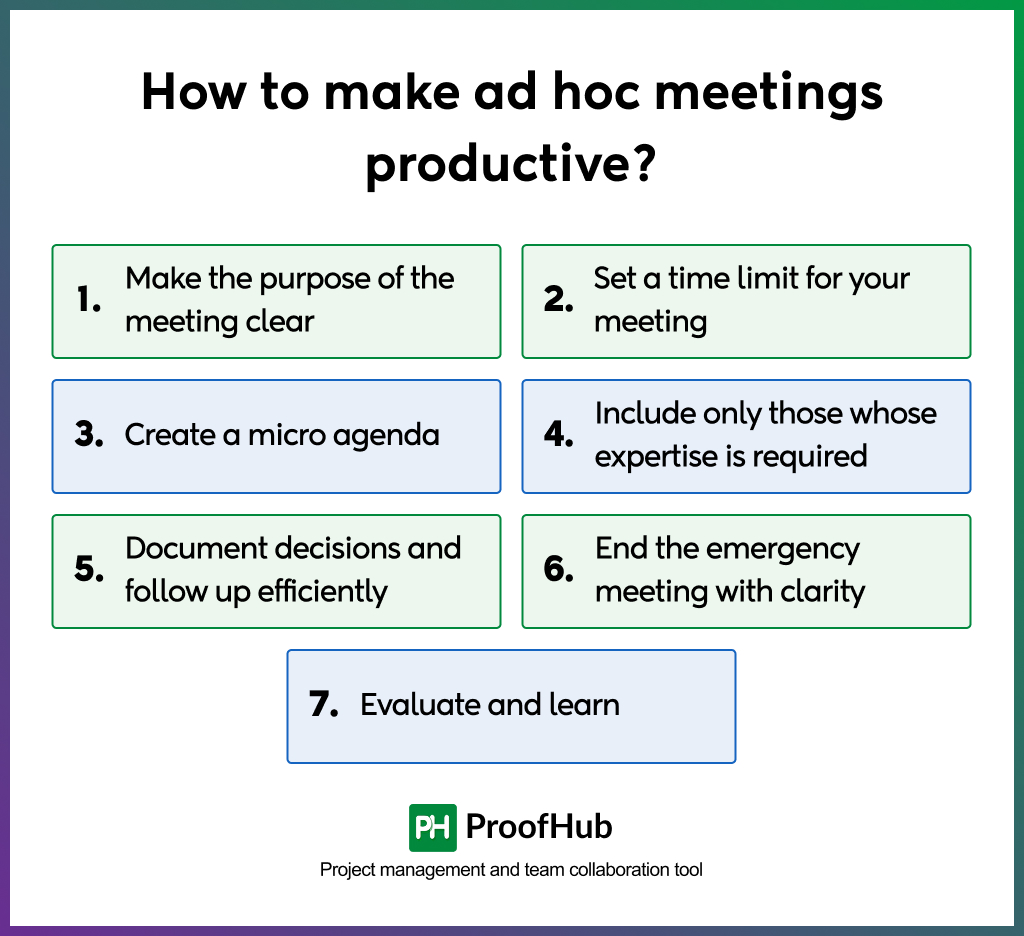
Let’s get into how you can make your one-off meetings effective as well as productive!
1. Make the purpose of the meeting clear
One of the biggest mistakes managers make is calling an ad hoc meeting without determining if it is truly necessary. Before you send out an urgent message to your team, make sure to assess:
- Does the situation need attention now?
Consider whether this issue needs immediate attention or can wait until the scheduled meeting. True urgency includes the situations that directly impact current work, deadlines and customer relationships.
- Could this be handled asynchronously?
Many “urgent” matters can be handled through emails or messages. Some emergencies require you to collect quick opinions, you can do that without a meeting.
- Check what kind of outcomes are needed?
You must have a clear idea of what you want from that particular meeting. Assess what outcomes you need, if it is a decision, if any information needs to be shared or if a problem needs to be solved. When the objective is determined, you can easily check if there is a need for a meeting and decide who will be a part of it.
- Who are the stakeholders?
Identify the people whose presence or input is essential to resolving the current issue.
After assessing all these factors, if you feel that synchronous collaboration is the only option to go about the situation, you must proceed with an ad hoc meeting. Tell the contributors about the problem beforehand so they come prepared.
Alternatively, share updates in ProofHub’s discussion boards and @mention key decision makers if inputs are needed.

2. Set a time limit for your meeting
Time boxing is crucial for such impromptu meetings because they are disruptive to everyone’s workflow.
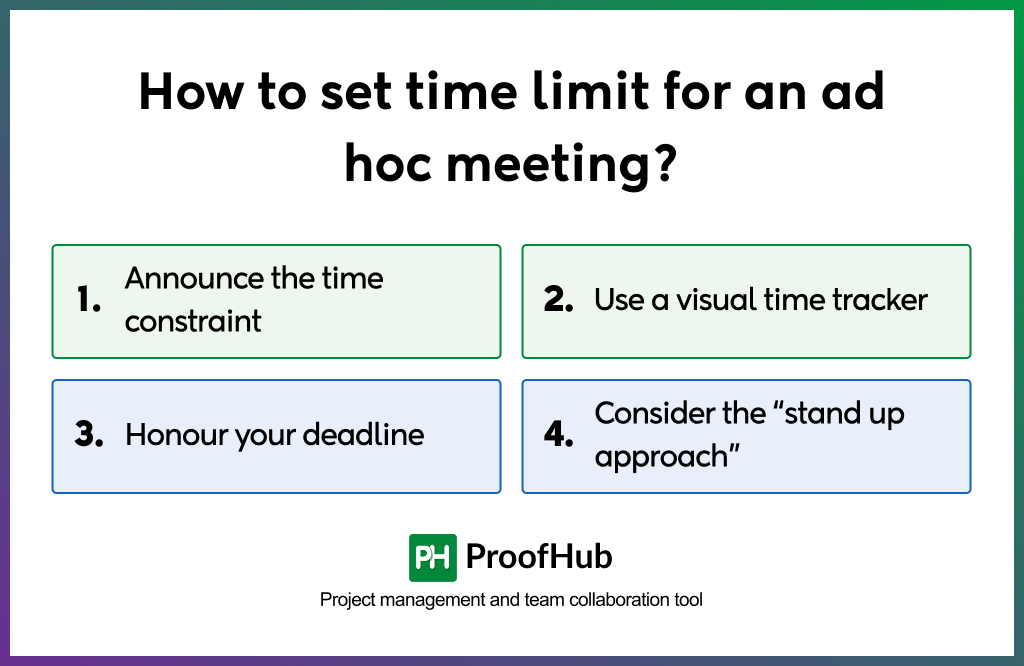
- Announce the time constraint at the beginning of your meeting. Address the team members in the meeting that you have exactly “x” minutes or hours to resolve this issue, so you set clear expectations. According to Parkinson’s Law, work expands to fill the time allotted, so the shorter timeframes usually give the same result as the longer ones.
- Try to use a visual time tracker so you can keep a countdown timer on the table so everyone can see exactly how much time is left, so the conversations remain focused.
- You need to honour your deadline by setting a certain amount of time for an ad hoc meeting and ending the meeting exactly at that time. You can always schedule a follow-up if necessary.
- You can consider the “stand up approach” by having participants stand during the meeting can help you keep things naturally brief. According to a study by Allen C. Bluedorn and Daniel B. Turban, published in Journal of Applied Psychology shows that stand-up meetings are typically 34% shorter than seated ones, with no decrease in decision quality.
3. Create a micro agenda
Even though these meetings are impromptu and don’t give you the time to prepare a structure for the meeting, you can always try to make a brief structure.
What do you need to do?
In the first 60 seconds, you need to establish:
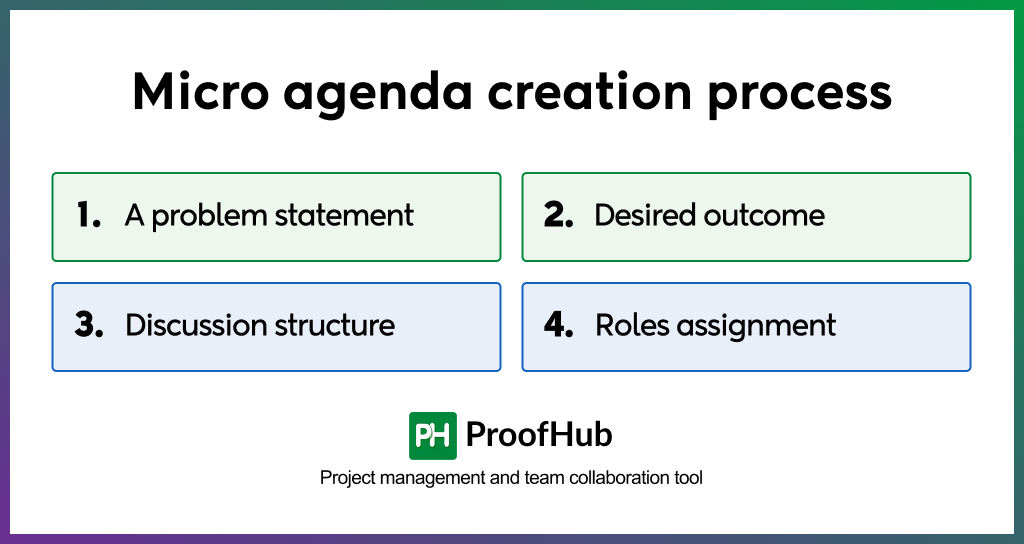
- A problem statement: Start will a discussion of the issue at hand. By doing this, you can highlight what will be the focus of the meeting and prevent the discussion from wandering.
- Desired outcome: Make a clear picture of what a successful resolution looks like.
- Discussion structure: Try to break the conversation into time segments. For instance, 5 minutes will go to problem sharing, 7 minutes to brainstorm solutions, etc.
- Roles assignment: Delegate the task of taking notes and watching time to someone so the meeting stays on track and the outcomes are not lost in the discussion.
Use Notes in ProofHub to prep micro-agendas on the fly. Start your free ProofHub trial.
4. Limit the number of invitees
The effectiveness of meetings tends to decrease as the number of participants increases:
- Identify the decision-makers and subject matter experts. Include only those in the meeting who can provide critical input or have the power to make decisions. Think before inviting if this person’s absence can impair the ability to resolve issues.
- You can also try to apply the “two-pizza rule” popularized by Jeff Bezos. It suggests that if it takes more than two pizzas to feed everyone in your meeting, the group is too large for effective decision-making. For a one-off meeting, 3-5 people are optimal.
- Take the RACI approach into account to identify the potential attendees. Only those in the first two categories typically need to attend the actual meeting.
- Responsible for taking action
- Accountable for the decision
- Consulted before a decision
- Informed after the decision
5. Document decisions and follow up efficiently
The value of ad hoc meetings vanishes if you don’t note down the outcomes.
- Use a format in documentation: You can structure your documents with the following sections:
- Decisions made
- Action items with clear owners
- Deadlines for each item
- Resources needed
- Communication needed
- Set a concise summary: Within an hour of the meeting, distribute a brief recap to all participants and stakeholders. Keep it under 200 words with bullet points for scanning ease.
- Create calendar invites for deadlines: Send calendar invitations for critical follow-up deadlines to maintain momentum and accountability.
6. End the emergency meeting with clarity
The opening as well as the closing moments of an unplanned meeting must impact its effectiveness.
- End the meeting with a decision confirmation: Whenever you end a meeting, you need to reinstate the decisions made in the meeting.
- Thank your team: Express gratitude to your team for pivoting quickly to address the issue. This will make your future collaboration easy.
7. Evaluate and learn
Improving your ad hoc meetings requires deliberate reflection.
- Track patterns: Keep tabs on the topics of the emergency meetings and how frequently they are occurring. Look for patterns that indicate systematic issues that require attention.
- Try to resolve issues at their core: When you notice the same issue is the cause of these recurring meetings, you can build mechanisms to address them in the regular workflow.
- Gather quick feedback: Ask the participants to rate the meetings on a scale of 1-5 for effectiveness and necessity. Use that feedback to refine your approach.
Fact: A recent article in Harvard Business Review says 92% of employees consider meetings costly and unproductive.
When you implement these strategies, you get to transform the potentially disruptive emergency meetings into focused, problem-solving sessions and maintain team productivity. These tips will help you find a perfect balance between addressing what is important and protecting time for team performance.
Why do managers need to get ad hoc meetings right?
As a manager, when you are already balancing daily standups, project updates and performance reviews, the idea of adding an unscheduled meeting is probably the last thing you want to do. But the truth is, handling impromptu meetings right is a leadership skill. Here is why getting them right matters:
1. They keep teams aligned: When priorities suddenly shift and decisions need to be made, a well-run ad hoc meeting can prevent delays and confusion. It keeps everyone on the same page by preventing the need for long email threads or miscommunication.
2. Unaddressed issues can escalate: Minor roadblocks often turn into full-blown crises if they are not addressed early. Knowing when to pause and gather the right people can stop problems before they grow bigger.
3. No prep time and high risk of going off-track: Since ad-hoc meetings happen on such short notice, there is usually no time to prepare. Without a clear focus, it’s easy to go off-topic and leave everyone more confused than ever. Therefore, start every meeting by clearly stating the goal, like ‘we are here to resolve (specific issue) to keep the discussion focused and effective.
4. No follow-through creates more work: More challenges come up if the issue at hand doesn’t get a solution. Summarize key takeaways and don’t wait until later, as it can make follow-up effortless for everyone.
What are the challenges with ad hoc meetings (and solutions)
A business gets benefits from how quickly you respond to the emergency and resolve it. One-off meetings are perfect to discuss unexpected situations, so you can give an immediate response to those issues. However, several challenges can come up with vigilant reactions to the problems.
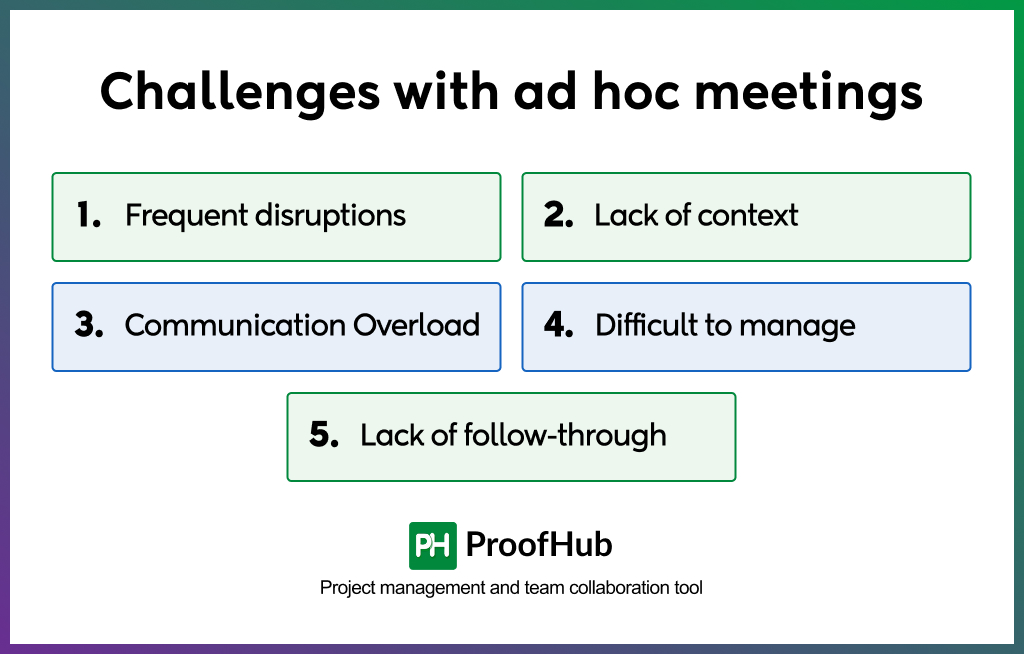
Let’s understand those challenges and how you can overcome them:
1. Frequent disruptions
One of the significant challenges among managers while arranging impromptu meetings is frequent disruptions in deep work. It becomes really difficult for them to get back on track once distracted. People who are constantly interrupted have comparatively more workload, more stress and higher frustration.
Solution:
To solve this, you need to evaluate the urgency of the issue. You can always schedule these impromptu meetings when it is less likely to disrupt employees’ deep work. Try to provide employees with advance notice so they will know how to manage their time. Also, you can try to invite only those whose contribution will impact the decision. So you can create an announcement in advance where you can invite only those whose involvement is crucial. Those who are invited to the meeting will get a notification of the time of the meeting.
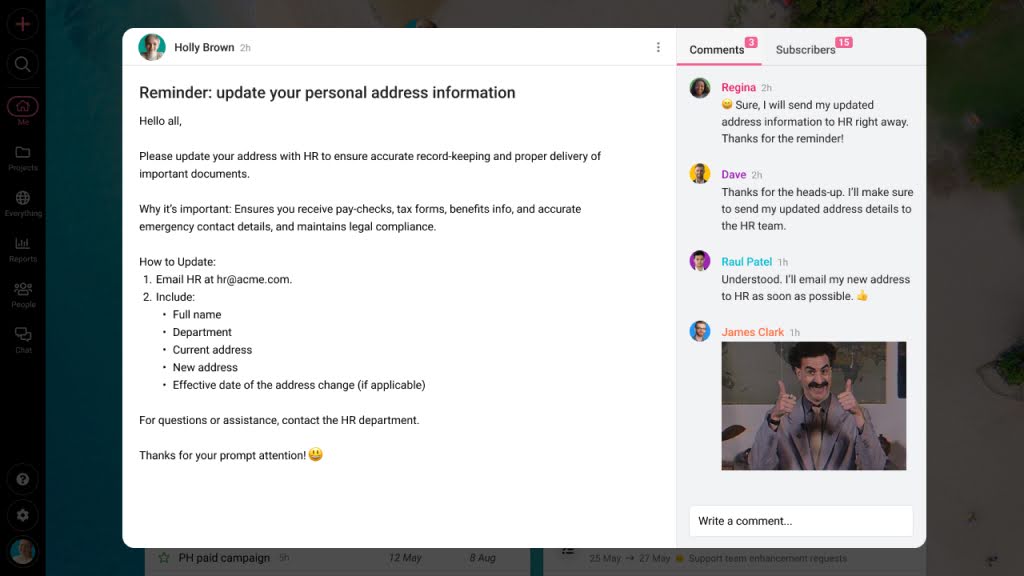
Use Announcements in ProofHub to align your team instantly. Share quick updates, meeting context, or must-read resources before the call.
2. Lack of context
The second challenge managers face is when employees have no idea what the meeting is about, and they come unprepared. This can lead to less productive sessions.
Solution:
To overcome this challenge, you need to brief them a little about the meeting a little when you make the announcement. You can also create an agenda and keep the information in bullet points so the employees can easily know what this impromptu meeting is about and come ready. With ProofHub, you get the opportunity to attach files to the announcement. So you create a separate file of the meeting agenda and attach it with the announcement itself.
3. Communication Overload
When ad hoc meetings happen frequently, information overload happens. Due to this, the communication channel gets cluttered, which eventually overwhelms the team members.
Solution
To overcome this challenge, you need to have a centralized communication channel so the discussions and decisions stay in a single place. This also helps in keeping all the critical information in a single place, and nothing gets lost in multiple applications.
4. Difficult to manage
The impromptu nature of these ad hoc meetings can make it difficult to arrange them. It can also lead to chaos and decrease efficiency.
Solution:
You can use tools like ProofHub for easy team collaboration. This tool can help you in note-making, so you can remember what needs to be discussed, the prime agenda and the solution needed. In addition, you can also communicate with all the participants in real time and in a single platform. It can help manage. The impromptu meeting was easy.
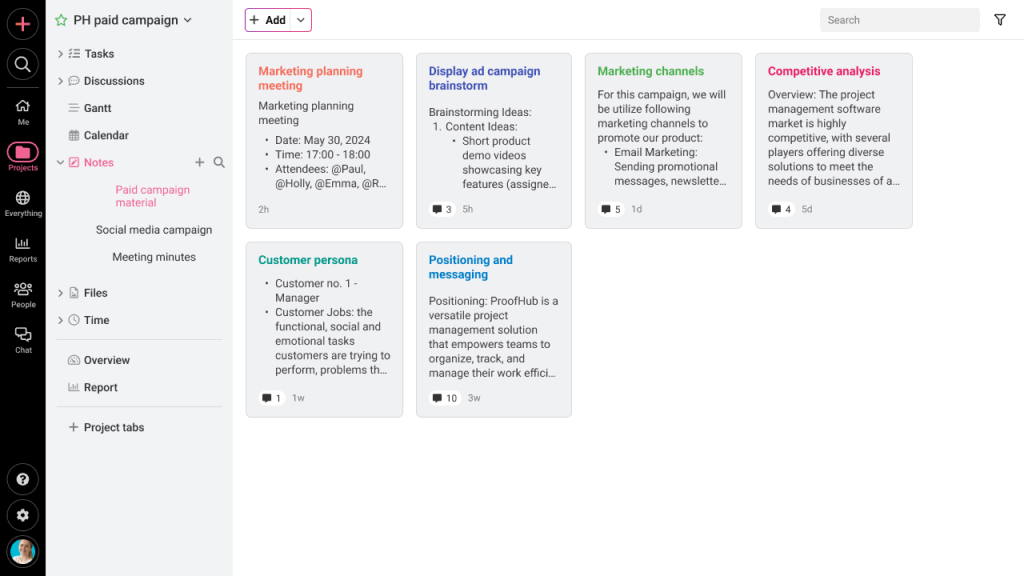
5. Lack of follow-through
Ad hoc meetings often end with a decision or an actionable result, but there is no follow-up. This results when the same problems resurface and nothing gets done.
Solution:
To resolve this issue, what you need to do is document all the action items so there is clarity over what was decided and who is responsible for each section. Also, you can use tools like ProofHub so you can assign action items directly to the participants so you can ensure everyone knows the next step.
Advantages of ad hoc meetings
These impromptu meetings hold several benefits in the workplace. The following are some of them:

1. Take less time than regular meetings
An unplanned meeting takes less time to schedule and wrap things up than a regular meeting. If compared with regular workplace meetings, these meetings take a shorter amount of time than a regular one. These kinds of meetings don’t have any lengthy agendas, these meetings tend to solve problems at hand as soon as possible.
2. Have a clear objective
The unplanned meetings may have a single and clear objective. The problem needs to be discussed in the meeting, and participants try to conclude. These meetings will help the employees understand their roles and responsibilities in managing unexpected situations.
3. Resolve emergencies
Organizations can face situations that require urgent decisions. Due to a wide range of factors, companies may have to face problems that require urgent solutions. These impromptu meetings ensure that your employees can quickly create solutions for them. These meetings create plans so that the negative situations have the least impact on organizations.
4. No need for a conference room
These meetings don’t need a specified location, you can choose any location for your emergency meetings. These meetings are generally smaller because they involve less number of people. So it becomes easier to choose a space for the gatherings.
5. Ideal for small groups
These off-site meetings are ideal for groups of a small size. These meetings often include department heads, managers and key employees. These small groups allow a simplified decision-making process. This impromptu meeting ensures that employees who have expert knowledge contribute and tasks are distributed accordingly.
Conclusion
To conclude, ad hoc meetings can be a nuisance to your employees’ regular schedule. With the right strategy, they can become powerful tools for agility and quick decision-making. The key is to plan even unplanned meetings with great effectiveness, from knowing when to call one, setting a clear purpose, and keeping the group small and focused. While these meetings may interrupt the flow of a regular workday, well-managed impromptu meetings can resolve urgent issues.
Ultimately, it is not just about impromptu meetings, it is about making them productive. With structured meetings and the right tools, you can transform emergency meetings into meaningful moments of progress.
Frequently asked questions (FAQs)
What are the signs you’re having too many Ad hoc meetings?
If your team is facing constant disruptions, repeated discussions and declining productivity, you may be holding various impromptu meetings. When emergency meetings become the norm, they signify deeper issues like poor planning, unclear communication, or a lack of structured norms.
Do ad hoc meetings have a formal agenda?
These kind of meetings don’t have any formal agenda as the prime motto is to resolve the issues at hand. However, a brief structure like a clear goal can keep these meetings productive and stick to the problem that needs attention.
What is an example of ad hoc?
A perfect example of ad hoc is when a manager spots a sudden technical issue and quickly asks the development and Quality Analyst to discuss and resolve it. These meetings are not scheduled or recurring, these are specifically to address the unexpected situation.
What is ad hoc full form?
“Ad hoc” isn’t an acronym, so it doesn’t have a full form. It’s a Latin phrase meaning “for this” or “for this purpose.” It describes something created or done to address a specific need, like a temporary team or meeting formed to solve an immediate issue.

